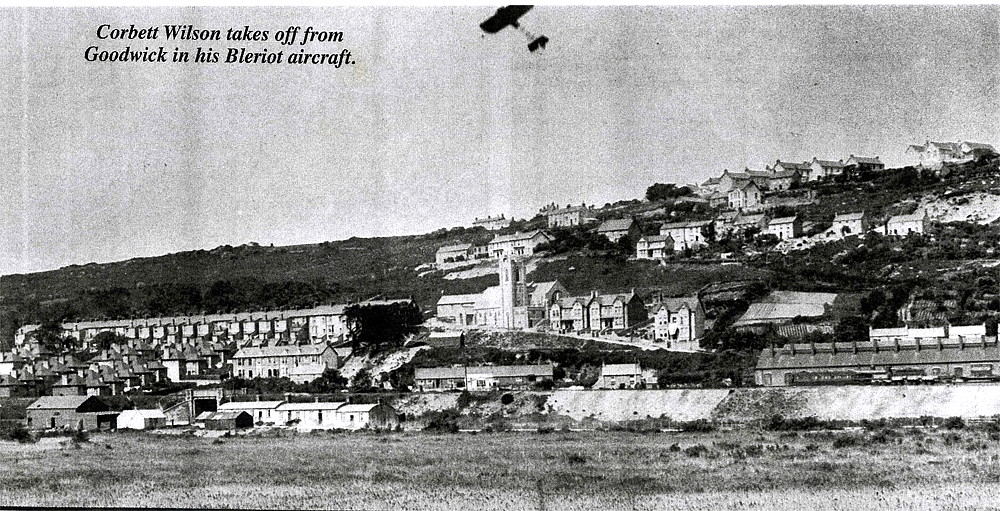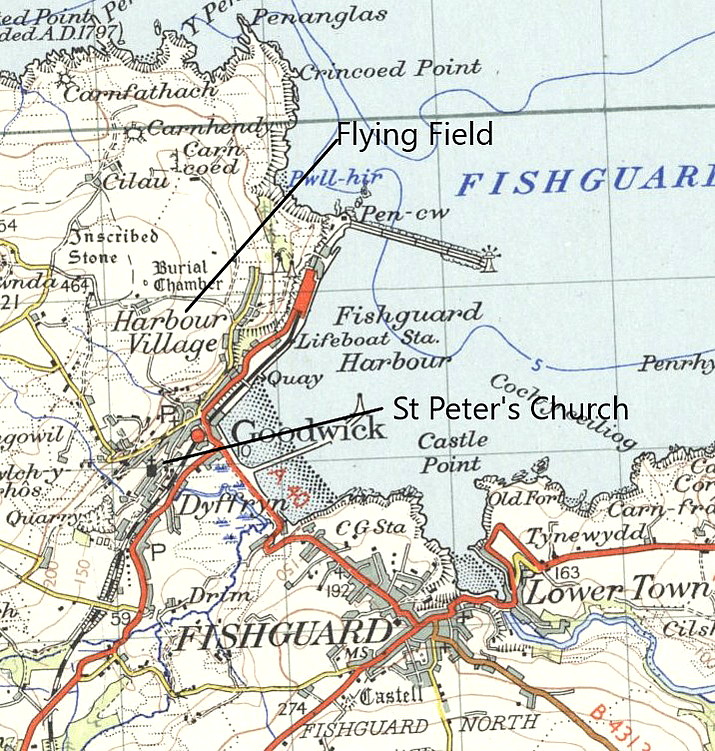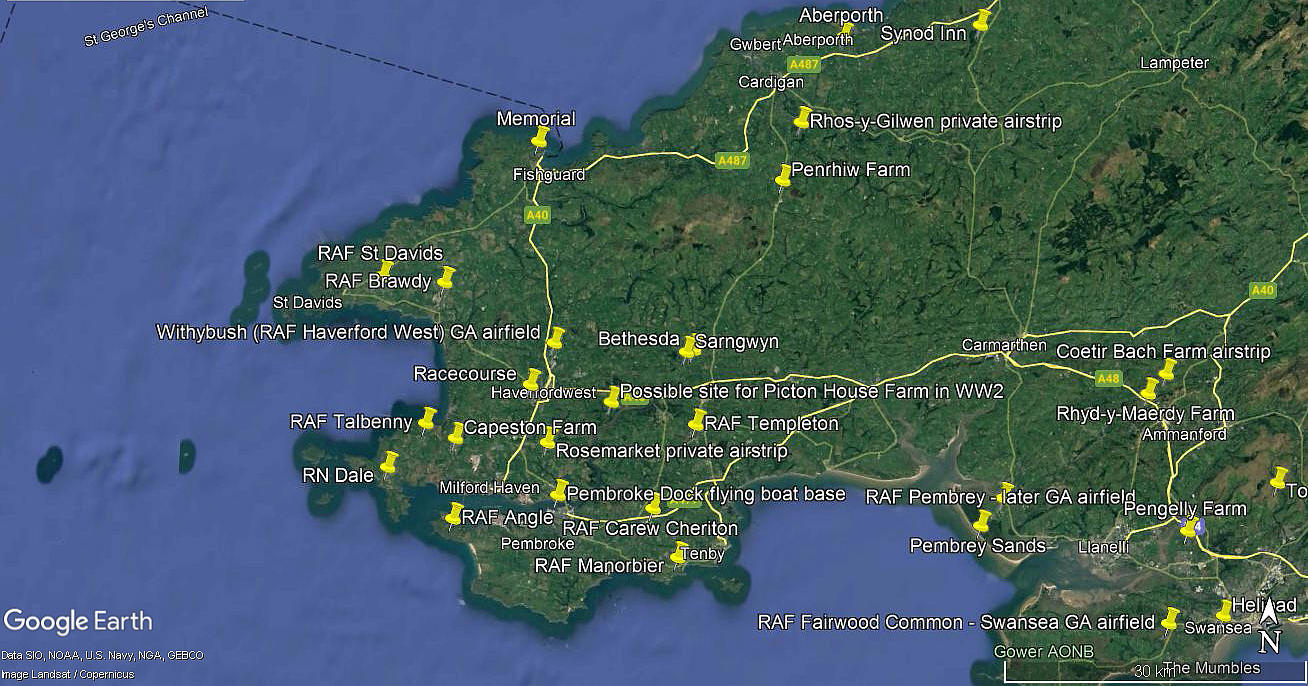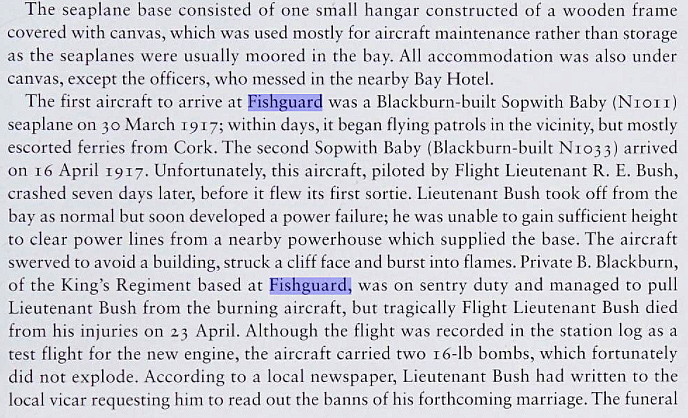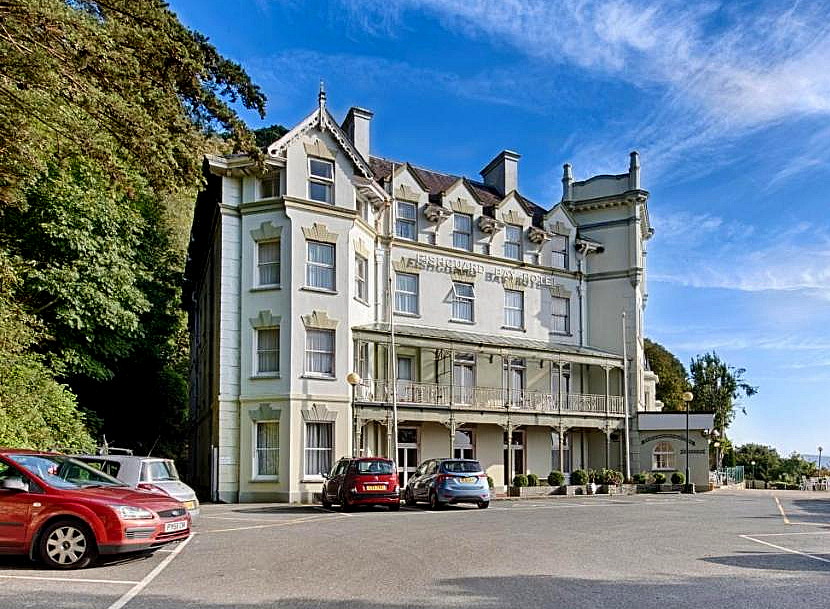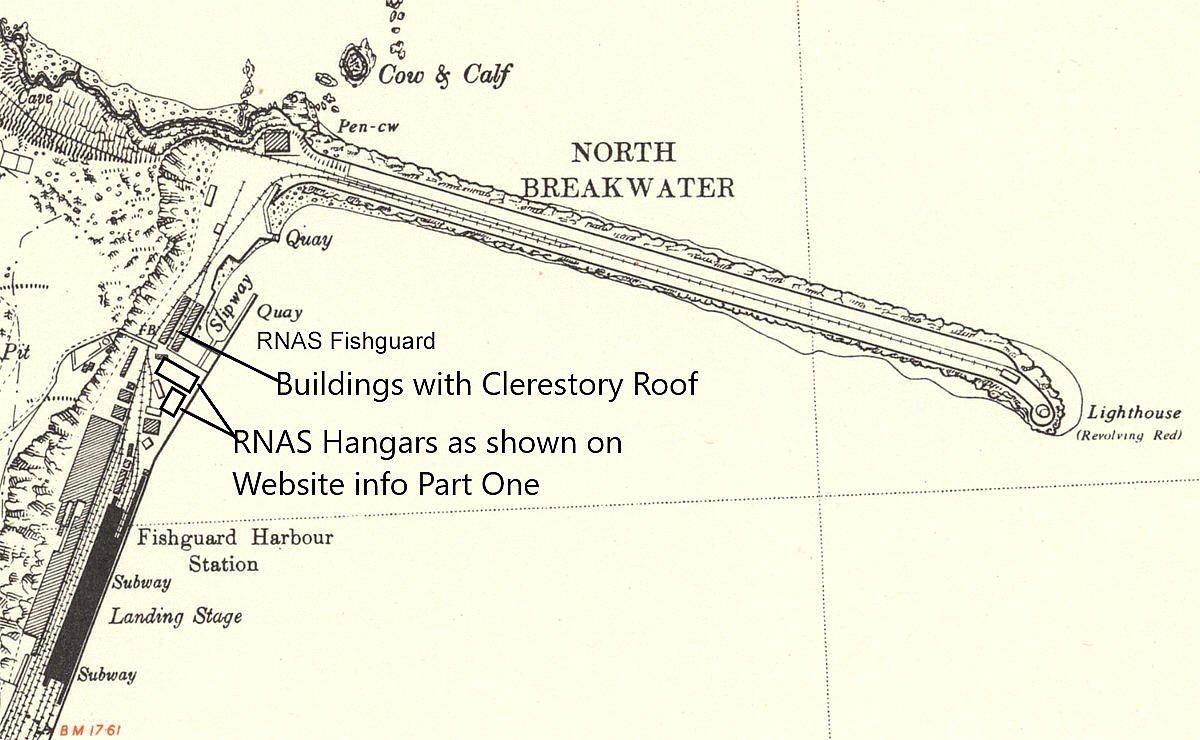Fishguard flying sites
Note: This map gives only my rough guess as to where the WW1 Seaplane Station was situated.
FISHGUARD: Temporary landing site (Aka GOODWICK)
NOTES: It has been a constant problem during the over twenty years I have spent in research for this 'Guide' to try and determine reasonably accurate accounts of the history, especially for the earlier years. This said, when I started, I mostly relied on books and magazines - the interweb was just getting going. For example, I have no idea when or where, I came across this account:
"In 1912 the Irishman Mr D Corbett Wilson flew from Paris to Ireland, (almost certainly on a Blériot monoplane?), making stops at AMESBURY (WILTSHIRE) and at FISHGUARD." Without too much doubt this is incorrect. It seems fairly certain the trip to FISHGUARD commenced at HENDON.
In March 2022 I asked Mike Holder, a great friend of this 'Guide, if he would be kind enough to have a look. The results he found, I trust you will agree, are quite astonishing. It now appears that Denys Corbett Wilson was the first pilot to make a successful crossing of the Irish Sea, from FISHGUARD in South Wales to Crane near Enniscorthy in County Wexford, on the 22nd April 1912. This really is a most dangerous crossing, the Irish Sea having quite severe tidal flows and unsettled sea states most of the time throughout the year.
The then well known actor/aviator Robert Loraine had attempted a crossing on the 11th September 1910, but crashed into the sea a few hundred metres from the Irish shore, but thankfully surviving.
A BIT OF HISTORY
It appears that Corbett-Wilson first started to learn to fly from HENDON, and didn't do very well, crashing two aircraft. He then went to the Blériot school at Pau, in France, and it seems got on very well here.
THE RECORD ATTEMPT
Records appear to show that this was a race between Denys Corbett Wilson, (the hyphen seems to disappear from time to time), and his friend Damer Leslie Allen, both flying identical Blériot XI machines. They both departed from HENDON on the 17th April, and Allen favoured a route via Chester and Holyhead on Anglesey. Ahead of the race at that time, aiming to land near Dublin, he vanished without trace.
Meanwhile, Corbett Wilson was having severe problems trying to reach Fishguard. Putting down in Herefordshire, (see the listing for NEWCHURCH), and later somewhere in Wales. (Colva in Radnorshire), It also seems that Vivian Hewitt had decided to enter the race, flying from Anglesey, but was grounded by thick fog. It now seems that Corbett Wilson took off from GOODWICK at 05.47 BST on the 22nd April 1912, and, as stated above, more or less crash landed in or near Enniscorthy, badly damaging his aeroplane in the process. The flight, it is claimed took exactly 100 minutes.
Flying long distances in those days was very much an unknown science at best. By todays standards those early pioneers only barely understood the very basics of how aeroplanes flew. They quite literally learnt by trial and error, a serious error often being fatal.
A SAD END
At the beginning of WW1 Corbett-Wilson joined the Royal Flying Corps, and was commissioned as a second lieutenant in the Special Reserve. He served with No.3 Squadron at Béthune in northern France, and was promoted to lieutenant. On the 10th May 1915, flying a Morane-Saulnier Type L, his aircraft was hit by an artillery shell. He was buried with full military honours by the German Army at Fournes-en-Weppes.
A MICHAEL T HOLDER GALLERY
Note: The second item was published in Aeroplane magazine on the 25th January 1912.
Note: The picture is of Denys Corbett Wilson ready to depart. But what is that 'binnacle' in front of him? Possibly a weatherproof map holder? The extract is from Early Aviation in Ireland by Bob Montgomery.
Note: The eighth item, the photo, is surely a composite, which were very common where aircraft were involved. The climb angle is quite ridiculous and a Blériot XI would have stalled before reaching this stage in flight. The ninth item is from 200 Years of Aviation in Ireland, by Donal MacCarron. The last and eleventh item is from my Google Earth © derived database.
FISHGUARD: Military Seaplane Station
Picture by the author.
Military users: RNAS/RAF Marine Operations (In April 1918 transferred to RAF control)
Location: Fishguard railway station adjacent to site
Period of operation: 1917 to 1919
Site area: 2 acres (Land)
NOTES: It appears that Sopwith Babys built by Parnall (probably at their YATE factory) were flown from here. Is any information known about other types flown here - assuming of course that there were other types being operated.
I suppose it is reasonable to assume that the two acre land site later became part of the area used by the later ferry terminal? After visiting the site to catch a ferry to Ireland in 2017, where else could it have been? But, there is something else to consider as today there are two railway stations situated quite close together - the station for Fishguard town - and, a few hundred metres furtther on, the station serving the ferry port.
A few years ago I made this comment: "If anybody can offer advice on this, it will be very welcome indeed." In March 2022 Mike Holder, a great friend of this 'Guide' came up with much extra information. See below:
A MICHAEL T HOLDER GALLERY
Note: The second and third items are extracts from Wales and the Air War 1914-1918 by Alan Philips.
Note: The website information was obtained from: www.hanesabergwan.org.uk. The Google Earth © picture shows the Fishguard Bay Hotel, once used by officers in the RNAS during WW1.
This ninth item, courtesy of the Fleet Air Arm Museum, shows the Short 184, serial N1242, being prepared for flight. In those days of course, quite a long and meticulous procedure. The eleventh picture is courtesy of the Imperial War Museum.
A BONUS ITEM
Mike Holder has also included the report about the accident involving the Sopwith Baby Seaplane, N1033 on the 22nd April 1917. Without too much doubt in this case, very serious pilot error. Quite probably due to him being poorly trained and lacking in operational experience. The exact figures are hard if not impossible to determine, but, it would seem, almost as many pilots were killed in training as in combat. A situation that had not improved during WW2.
We'd love to hear from you, so please scroll down to leave a comment!
Leave a comment ...
Copyright (c) UK Airfield Guide





















